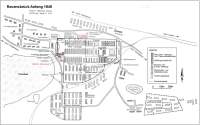 |
| Camp Map |
The Ravensbrück concentration camp for women near
Fürstenberg
(about 90 km north of
Berlin) was established in
1939.
The camp complex included a smaller KZ for men and the so called "Jugendschutzlager Uckermark" (a camp for young persons)
as well as 28 satellite camps ("
Außenlager"). Approximately 28,000 people perished in the
Ravensbrück camp complex.
The planned Gas Chamber "Neue Wäscherei" ("New Laundry")
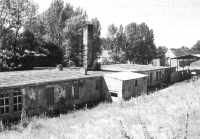 |
| The "Neue Wäscherei" |
Just outside of the northern camp wall is the site of the todays memorial. Near the former "Revier" there is a building
that was most probably erected to serve as gas chamber (with two rooms). It is the socalled "Neue Wäscherei".
The construction works started in
October 1944 but were delayed, probably
because of a lack of material. Because of the situation at the front in
late January / early
February 1945 the camp authorities had to find a temporary solution for gassing purposes. It is also possible
that the prisoners who had to build the "Neue Wäscherei" gas chambers delayed the works intentionally so that
this killing facility never went into operation.
 |
| The "Neue Wäscherei" |
One can assume that the former
Auschwitz commander,
Rudolf Höß (in his capacity as chief of the WVHA office DI),
together with his superior
Oswald Pohl and camp commander
Fritz Suhren; inspected the construction works
between
end of February and mid March 1945. This was witnessed by
Walter Jahn who
had been imprisoned in the menís camp since
1941. As an electrician he had to install cables in
the "Neue Wäscherei", and testified against
Pohl in
Nürnberg. In addition he drew a sketch of the gas chambers for the court.
There are also testimonies from usually reliable witnesses about the use of mobile gas chambers or the installation
of a gas chamber in an adapted Dutch railway wagon that was parked in a pine wood behind the so called "Siemenslager".
However these statements are questioned by some researchers.
It is notable that defendants of the Ravensbrück trials (altogether seven trials) freely mentioned a gas chamber
in the "former barrack" but never mentioned another gas chamber (in the "Neue Wäscherei").
The Gas Chamber in the Barrack
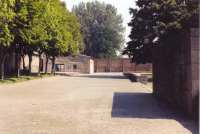 |
Crematory and
Gas Chambers Barrack |
No plans or remnants of the building are available. Therefore all facts about this real gas chamber of
Ravensbrück are based on the testimonies from witnesses (SS men and former prisoners) who
all agreed about type and location of the gas chamber. This provides firm evidence to support the existence
of the gas chamber. It was installed in the warehouse barrack of the
Malerkommando (painterís
command) that was located directly beside the crematorium. The barrack was emptied and then sealed.
The gas (Zyklon B) was poured into the gas chamber through an opening in the ceiling. Some witnesses
stated that this has been done by prisoners but this can be doubted because the SS usually did it itself.
According to witnesses one side of the gas chamber could be turned down to facilitate the removal of the
corpses and the ventilation. Others talked about double doors. To hide the crime a two metre high fence
was built around the barrack.
A few metres away from the barrack a small shed was located. Here the victims had to undress before the
SS drove them to the gas chamber. It is not clear if SS doctors were present at the gassings.
The prisoners who were forced to work in the gas chamber came from the smaller menís camp. As "hearer
of secrets" they were killed by the SS on
25 April 1945 in the bunker,
shortly before the evacuation of the camp.
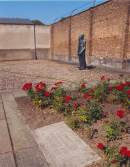 |
Memorial for the
Gas Chambers Barrack |
The exact procedure of the gassings cannot be reconstructed with absolute certainty because of the
variance in the reports of the different witnesses.
There is still some uncertainty about the size of the gas chamber. Witnesses, such as the
Schutzhaftlagerführer
SS-Hauptsturmführer Johann Schwarzhuber, who had
relevant experiences from his former job at
Auschwitz-Birkenau,
stated that the size of the gas chamber measured 9 x 4.50 m. Former prisoners declared that the size was 4 x 6 m.
The difference may come from the fact that a wall had been erected so that a small anteroom was created. That means that the
gas chamber could have had a size of approximately 20 m
2.
Schwarzhuber
specified the capacity of the gas chamber at 150 persons.
There is also disagreement about the number of victims. The gassings started between
end of
January and early February 1945. The killings continued until
end of April.
The last gassings might have happened on
22 or 23 April 1945 (the camp was liberated on
30. April 1945).
Schwarzhuber stated that the number of victims was 2,300-2,400.
Others, like the researchers
Bernhard Strebel and
Anise Posel-Vinay, estimated the number of victims at 5,000-6,000.
The aim of the gassings was to exterminate ill prisoners and those who were not able to march longer distances
before the camp's evacuation.
Schwarzhuber's statement that the
gassings started in
late February is undoubtedly wrong. According to the diary
entries of witnesses'it was
early and mid February. In addition, some of the very
rare camp documents show that by
mid February lists were drawn up which
clearly show that the people "went into the gas".
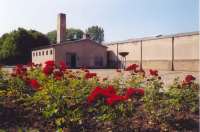 |
View from the former Gas Chamber
to the Crematory |
The selected women mainly came from the socalled "
Jugendschutzlager Uckermark", 1.5 km away from
the main camp. A part of this camp had been selected by the SS in
January 1945
for the separation of ill, elderly and those women from the Ravensbrück main camp who were unable for work.
This may possibly be traced back to
Himmler's order (from
autumn 1944) to camp commander
Suhren
to kill 2,000 prisoners per month. The women were accomodated in barracks without beds, latrines and water.
Because the women were set on "half rations", having got neither coats nor blankets, and because of newly invented
and senseless roll calls, one can say that this was a "death zone", led by
Ruth
Closius-Neudeck, who told about the camp and the gassings at her trial.
In the afternoon selections took place to select the most weak women. They were brought to the socalled "
Turnhalle"
(gymnasium) from where they were picked up by the SS in the evening and brought to the
Stammlager.
To prevent rumour and chaos, the women were told that they should be transferred to other and better camps.
Lists were compiled which should show that the women were transferred to a camp called "Mittwerda". These lists
contained approximately 4,000-5,000 names. The camp "Mittwerda" didn't exist. Everything was just camouflage
for the murder. In addition, from satellite camps and the men were brought to the gas chamber and gassed.
The last gassings happened when the Swedish Red Cross was in the camp to compile transports with weakened
prisoners to carry them to neutral Sweden (via the still occupied Denmark).
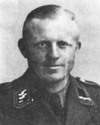 |
| Otto Moll * |
In the beginning the women were shot. Because this method was too time-consuming and noticeable, it was
changed into gassing in
end of January. The shootings as well as the
gassings were supervised by
SS-Hauptscharführer Otto Moll.
Moll, who already has had experience of gassings at
Auschwitz-Birkenau (chief of the crematories),
ended his gassing career at Ravensbrück.
Even after the establishment of the gas chamber the shootings continued in Ravensbrück. The gas
chamber staff consisted of SS men with experiences in
Auschwitz,
for example their chief
Schwarzhuber, who was
Schutzhaftlagerführer of the mens camp in
Auschwitz-Birkenau.
During the first Ravensbrück trial in
Hamburg
(
1946)
Schwarzhuber stated:
"
I was present at a gassing. 150 women were always forced into the gas chamber.
Hauptscharführer Moll ordered the women to undress
and that they had to join a delousing. Then they were led to the gassing room and the doors were closed.
A male prisoner, wearing a gas mask, entered the roof and threw a gas can through a small opening, which he
immediately closed after that, into the room. I heard groaning and whimpering in the room. After 2-3 minutes it
became silent in the room..."
The SS attempts to keep the gassings secret, failed. A female German prisoner could secretely add
(already under the date
9 February 1945) to her diary:
"
Something terrible: Those who were sent on transport yesterday were
sent to the gas chambers..."
In
December 1947 the chief warder of the camp "Uckermark",
Closius-Neudeck, testified:
"
When the vans were completely filled, both SS men and I drove in the
direction of the crematory. There we had to unload the prisoners at a toolshed. In my function as
Oberaufseherin I ordered them to undress completely (...) When all women were undressed,
a disguised SS man in a white coat brought the women, one after the other, to another toolshed.
When this shed was filled, it was locked. Then two male prisoners were ordered to enter the roof.
I have seen how they dropped something there. Then the opening on the roof was closed. After the two
prisoners had climbed down the roof, the motors of the lorries were switched on so that the screaming
of the victims could not be heard."
In the night of the
23 April 1945 the barrack was blown up
by the SS, according to some witnesses. Therefore no important traces remained after a few days
when the camp was liberated by the Red Army. In contrary other witnesses stated that they still had
seen the barrack shortly after the end of the war.
We don't know if the foundations of the barrack are still there: The site where the barrack was located,
was converted into a DDR memorial after the war. It became a part of the graves field at the camp wall.
An archeological inspection to locate the exact site of the gas chamber would disrupt the todayís graves.
A positive result would not be predictable anyway.
Schwarzhuber, Moll, Closius-Neudeck, Pohl, Höß
and the former commander
Suhren were finally sentenced to death and executed.
Photos:
Auschwitz Museum
*
Sources:
Strebel, Berhard:
Das KZ Ravensbrück. Geschichte eines Lagerkomplexes. Paderborn 2003
Tillion, Germaine:
Frauenkonzentrationslager Ravensbrück. Lüneburg. Zu Klampen 1998
Kogon,Langbein,Rückerl:
Nationalsozialistische Massentötungen durch Giftgas. Frankfurt a.M. 1983
Plewe,Reinhard/ Köhler, Jan Thomas:
Baugeschichte Frauenkonzentrationslager Ravensbrück. Berlin 2000
Müller, Charlotte:
Die Klempnerkolonne in Ravensbrück. Dietz Verlag Berlin 1983
Gutmann, Israel/ Jäckel, Berhard u.a.:
Enzyklopädie des Holocaust. München 1998
Philipp, Grit:
Kalendarium der Ereignisse im Frauenkonzentrationslager Ravenbrück 1939-1945. Berlin 1999
Schäuml;fer, Silke:
Zum Selbstverst/auml;ndnis von Frauen im Konzentrationslager. Das Lager Ravensbrück.
Dissertation, TU Berlin, 2002
(
www.edocs.tu-berlin.de/diss/)
© ARC 2005















